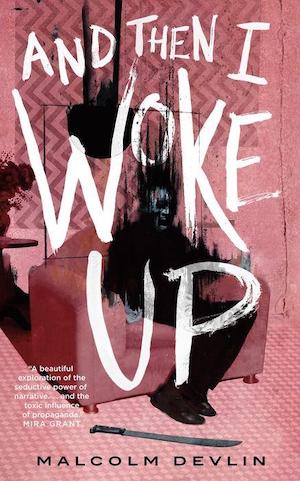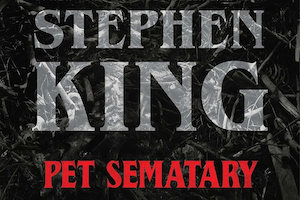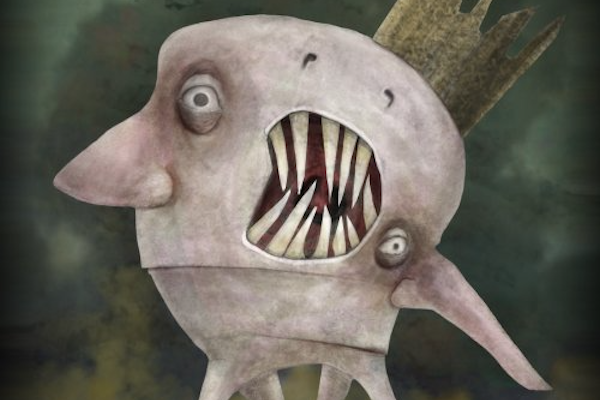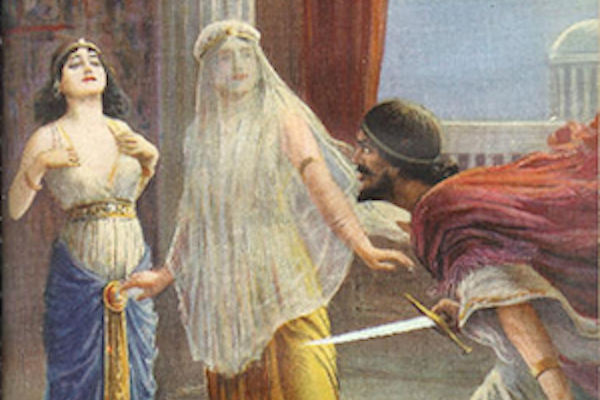Welcome back to Reading the Weird, in which we get girl cooties all over weird fiction, cosmic horror, and Lovecraftiana—from its historical roots through its most recent branches.
This week, we cover P. Djèlí Clark’s “Night Doctors,” first published in the August 2018 issue of Eyedolon, and available in the November 202o issue of Nightmare. Spoilers ahead!
“There’s what you don’t believe in, Mr. Bisset, and then there’s what you ‘fraid of.”
One August afternoon in 1937, a Black gentleman named Bisset arrives in Durham, NC. He’s working for the Federal Writers’ Project, interviewing former slaves. Finding lodging is difficult—the Chanford Motel proprietor ejects him with invectives and spewed tobacco juice. A Black butcher rents him a spartan room over his shop, warning that Bisset will have to put up with the smell of raw meat. Bisset voices no objection.
He dines at Mama Elsa’s, where in addition to a fine meal, she supplies gossip and suggestions on finding interviewees. Much later, dressed in an all-white suit with a matching white bowler and satchel, he slinks back to the Chanford Motel and neatly cuts the proprietor’s throat. Bisset assures the dying man this isn’t vengeance for their earlier “uncivil encounter”; he’s merely looking for something of which the proprietor should offer a “fine sampling.”
He proceeds to dissect his subject.
Interviews yield little until he meets 97-year-old Maddie Shaw. Disappointed he’s brought no sweets, she briefly relates the too-familiar tale of abuse by slaveholders. Why talk about “mean white folk”? They’re dead and gone, she hopes, to the Night Doctors. Mention of the Doctors makes Bisset eagerly trade his interview pad for a leather notebook. These beings, Maddie says, were men, “only dey was not men.” They’d abduct slaves and carry them to “a great white dissectin’ hall” for experimentation. Want to hear more? Come back with sweets.
Many believe white folks invented the Night Doctors to scare slaves into submission. But Bisset first heard about them at his medical school in Washington DC, then throughout the South. It’s curious how consistent the folktale is.
Mama Elsa sings a chilling song about the Doctors. She supposes Bisset asks about them because of recent murders in Durham. Four white people eviscerated, then sewed back up neat. Authorities suspect the killer’s a doctor, white naturally, because what negro has such skill? Bisset knows there’s a pattern investigators have missed: All the victims were guilty of abusing Black people.
Buy the Book


And Then I Woke Up
Plied with caramels, Maddie tells Bisset about a field hand named Jeremiah, so big and strong he feared nothing. As Jeremiah’s wife Adeline lay sick, Night Doctors slid under Jeremiah’s door easy as rats and with their weird whispering mesmerized her away.
Bisset admits he believes the Doctors are real, and can help him find the bodily source of hate. Jeremiah, Maddie continues, consulted a “conjurin’ woman” who said the Doctors lived in the dead Angel Oak in the woods. He found the Tree and confronted the Doctors. They refused to surrender Adeline but set Jeremiah free in exchange for his eyes. It was suffering they wanted, to fill the emotional emptiness inside them, and who had suffered more than slaves? If Bisset goes to them, they’ll set a price for his release too—what’s he willing to pay?
That night Bisset walks the woods around Durham—Maddie’s said he’ll find the Angel Oak if he wants to badly enough. In medical school he studied humorism; his notion is that in addition to its four ruling bodily fluids, there’s a fifth that causes hate. He’s sought the fifth humor in cadavers, then living bodies, without success. If anyone can root hate out, surely it would be the Night Doctors.
He finds the Angel Oak, or it finds him. Squat, bone-white, hung with skeletal remains, it bleeds when he cuts his way into its fleshy interior to a world of gargantuan white stone corridors. He hides from a huge centipede-like scavenger that comes to clean the blood he’s brought through from the oak. Something knocks him to the floor. It’s not the many-legged monster that drags him along, but gigantic white-robed men. No, not-men, with six-fingered hands and faces featureless except for wrinkles.
The Night Doctors strip Bisset, dump him onto a stone table, and produce cruel surgical instruments. He’s rendered immobile and mute by their telepathic whispers. Animal terror frees him to shout that he “can pay the price,” that he like them is an explorer, searching for more than the misery they savor. Help him find it, and he’ll share!
The Doctors pause. One demands to know what he offers. Hate is his reply, but how can he describe it to these beings?
Because he can’t describe it, the Doctors begin cutting, intent on reading his meaning in his innards. Bisset surrenders to his agony and “sings” the Doctors a “holy litany” about Black suffering and the hate that “consumes men’s souls like a ravaging cancer.” When the Doctors pluck out his eyes, he’s still singing.
Before dawn, Bisset visits Maddie. He tells her that the Night Doctors have shared their secrets and returned him to serve as their conduit to the promised feast of hate. Maddie, unflustered despite the eyeless horror he’s become, asks what price the Doctors required.
Looking down at his body, emptied now of every organ, Bisset says he gave all of himself. Then he collapses and, flat as a rat, squeezes under her door into the night.
What’s Cyclopean: Night Doctor hands earn an actual “cyclopean,” while their hall is merely “gargantuan.”
The Degenerate Dutch: Bisset’s victims are case studies in the hatred that so interests him, ranging from slurs and segregation to lynchings. Bisset goes unsuspected, because only whites are assumed capable of crimes that require education and skill.
Weirdbuilding: The Night Doctors—or Night Witches, Bottle Men, or Needle Men—are horrors grown from Haint stories, as inhuman in their motivations as any other eldritch entity.
Libronomicon: Dr. Bisset is ostensibly writing a book on the Night Doctors and similar “folklore.” He must be actually writing something (other than his research notes), or the Federal Writers’ Project wouldn’t keep paying him.
Madness Takes Its Toll: No madness labeled as such this week, though the rationality of Bisset’s choices is… questionable.
Ruthanna’s Commentary
In Ring Shout, we meet the Night Doctors as extremely uncomfortable and conditional allies. We learn about them the things immediately relevant to Maryse: their power, the costs they demand, the emotions that sate and overwhelm them. And we learn just a little about Bisset. Enough to wonder what would convince someone to work for those things. Where by “wonder,” I mean, what the hell, why would you want to do that? What could possibly be worth not just the “price” in flesh, but the company?
Bisset, it turns out, made interesting life choices long before meeting the Night Doctors in person. Maryse treads a fine line in the costs one might pay—the things one might be willing to become—to get vengeance and make the world a slightly better place. Bisset is so far over the line that it’s doubtful he even knows it exists any more. I will admit that I speak from my own biases as a hardass about scientific ethics. But speaking as a trained behavioral scientist who spends a certain amount of time reading up on the psychological and sociological origins of bigotry and hatred, I have quibbles with his research methodology.
And but so anyway. The Night Doctors are incredibly creepy, and not less so for finding out more about their motivations. If you can even call it motivation, when it comes from a complete lack of emotion. A void of emotion? In any case, the alien experiences of humanity intrigue them. And like any good (evil) scientist, they study those experiences. In great depth. We already know from Ring Shout that emotions with any positivity or power are inconveniently overwhelming to them, so naturally they go after the other kind. Unlike Bisset, they don’t even claim to have some greater good in mind. They just want to examine, in detail and with lots of replication. Also unlike Bisset, they have ways to get actual insight out of their vivisections. (A horrible practice that combines horribly with hepatoscopy.) Those ways are what Bisset seeks, what he’s willing to give up everything else for. With the Night Doctors’ methods, his killings could truly tell him something about the origins of hatred.
But with the price that he’s paid, it’s doubtful that he can still care about that outcome. He’s been initiated, has learned the tricks the Night Doctors know. And, perhaps, given up his humanity along with his viscera. Maybe you can only learn the things they learn if you lack the emotions that make those things matter.
Certainly, the purely human white folk whose depredations “inspire” Bisset’s research haven’t been learning much. That’s part of the point, isn’t it, that the Night Doctors and Bisset aren’t causing any suffering that hasn’t been outstripped in entirely mundane form by slavery, by lynchings, by all the violations that Bisset sings of through his pain.
In Clark’s universe, the line between human and eldritch monsters shifts and blurs: human oppression invoking or motivating supernatural horrors, eldritch abominations drawn to human horrors because they provide convenient doorways or sustenance or research material. Humans mistreat humans, and so sacrifice their humanity and bring the rest of the (uncaring, hungry, etc.) universe closer. Fortunately, we have people like Maryse and her comrades to provide some level of protection—but that’s not a possibility that Bisset’s even considered as a way to address hatred, and so it never becomes part of his reality.
Anne’s Commentary
I love a good origin story, so I was excited to read one about that dapper housecall-making physician Antoine Bisset. “Night Doctors” originally appeared in August 2018 in Eyedolon, then was reprinted in Nightmare Magazine shortly after Ring Shout’s October 2020 publication. I don’t know which Clark worked on first, the devilish-egg appetizer of the short story or the deliciously plump chicken of the novella. The conceptual precedence would matter if I aspired to write something like John Livingston Lowe’s Road to Xanadu (1927), which exhaustively dissected Coleridge’s “Kubla Khan” and “Rime of the Ancient Mariner” down to every source he could wring out of the poet’s notebooks.
My serious-literary-critic aspirations have never approached that feat. Background research? An interesting concept, Professor, but who has time when there are so many more novels and stories and plays and poems to read?
However, Clark’s novella and story have hooked me into reading more about the real Night Doctors. The actual monsters are far more horrific than the fictional ones because we can’t clap the book shut on them and wonder where writers even get their crazy ideas. Mama Elsa tells Bisset, “There’s what you don’t believe in…and then there’s what you ‘fraid of.” What we fear in real life, we turn to make-believe in art; now we can handle the scary thing, because it isn’t true. Only there’s nothing in good art that doesn’t have a basis in the truth, whether the connection is obvious or buried deep.
I found this article by Mark Laskey, “Fear of the Dark: The Night Doctors in Folk Belief and Historical Reality”, a good overview of the subject. Laskey points out that enslaved West Africans brought with them to the New World such folkloric creatures as the Asasabonsam (or Sasabonsam.) This being lurked in forest trees, from which it snagged night travelers with its long “hook-like” talons, dragging them up into the branches and draining their blood. I can see Sasabonsam attributes in Clark’s Night Doctors, especially the claw-like digits and those bony hooks with which they reeled in the Grand Cyclops. An Atlas Obscura article by Nicole Zakheim argues that the Sasabonsam, monstrous as they were, also served as guardians of the forest, enforcers of the natural “rules of renewal.” When Christian missionaries needed a Satan stand-in that Africans would appreciate, they made the Sasabonsam into “more purely devilish figures.” Fear controls, the scarier the fearful object the better. When slaveholders in America wanted to keep the enslaved at home nights (rather than plotting against their masters or running off), what better than to populate the dark with not only real “patterollers” and procurers of “research subjects” but with supernaturally powerful Night Doctors as well?
White members of the antebellum Night Patrols (and later, Klansmen) were known to use disguises and props to produce supernatural dread. Among these were ghostly white robes, hoods and masks, devil-horns, and various noisemakers. Clark’s Night Doctors have the white robes and heads that appear hooded and masked because they’re featureless, except for those deep fleshly wrinkles that might at a glance resemble wrinkles in cloth. Stilts could be employed to lend unnaturally imposing height. Clark’s Night Doctors actually are imposingly tall. Another prop was a false head that could spin 360 degrees; when she’s possessed by the Night Doctors, Jeremiah’s wife is owlishly able to turn her head full backwards.
Dr. Bisset enters his origin story already treading a personal road to perdition. After a lifetime of encountering hate, he makes hate his study. Learning in medical school about the “discarded notion” of humorism, he picks the notion back up. His hope is to localize hate in a particular bodily fluid, as yellow bile is the seat of aggression and black bile of melancholy. This accomplished, the “essence” of hate might “be counteracted or drained away, to ease the senseless and injurious emotion that has caused humanity such incalculable harm.”
To eradicate hate at its source is a laudable goal. To start the search in “the cold cavities of cadavers” seems harmless. To extend the search to “living specimens” is a dangerous leap into enemy methodology. To make one’s “inspiration” the Night Doctors of folklore—in story terms, the genuine Night Doctors—is to totter on the edge of a cliff.
Clark shows Bisset edging ever closer to the brink. During the day, he’s a mild-mannered Federal Writers’ Project interviewer; at night, like his Klan enemies and the Night Doctors themselves, he dresses in white and makes sinister house calls on those he deems socially undesirable. From a research standpoint, however, his victims are highly desirable, theoretically bursting with the sought-for essence of hate.
Bisset tells the motel proprietor he’s killing him for science, not for revenge. He’s a proper researcher, dispassionately curious. So Bisset likes to believe, but can he actually and figuratively plunge his hands into the guts of his enemies without contamination? Is the hate he “explains” to the Night Doctors only the hate felt by his people’s persecutors? Or, for the Doctors to truly taste and crave his offering, must he not provide the freshest, the firsthand emotion, his own hate?
The final irony is that in treating with the Night Doctors, Bisset becomes a Night Doctor, but a lesser one in service to them, the true lords of their world. The Doctors are empty inside. They make Bisset empty as well. The Doctors are perpetually hungry for stolen emotion. What does Bisset perpetually crave? I’d say knowledge, whatever he can glean from the leavings of the Night Doctors, but an empty knowledge now that he’s paid over his humanity as their price.
His everything, all of him.
Next week, we start on Joseph Sheridan Le Fanu’s Carmilla, Chapters 1-2, in which we learn the perils of buying a cheap castle!
Ruthanna Emrys’s A Half-Built Garden comes out in July 2022. She is also the author of the Innsmouth Legacy series, including Winter Tide and Deep Roots. Her short story collection, Imperfect Commentaries, is available from Lethe Press. You can find some of her fiction, weird and otherwise, on Tor.com, most recently “The Word of Flesh and Soul.” Ruthanna is online on Twitter and Patreon, and offline in a mysterious manor house with her large, chaotic, multi-species household outside Washington DC.
Anne M. Pillsworth’s short story “The Madonna of the Abattoir” appears on Tor.com. Her young adult Mythos novel, Summoned, is available from Tor Teen along with sequel Fathomless. She lives in Edgewood, a Victorian trolley car suburb of Providence, Rhode Island, uncomfortably near Joseph Curwen’s underground laboratory.













